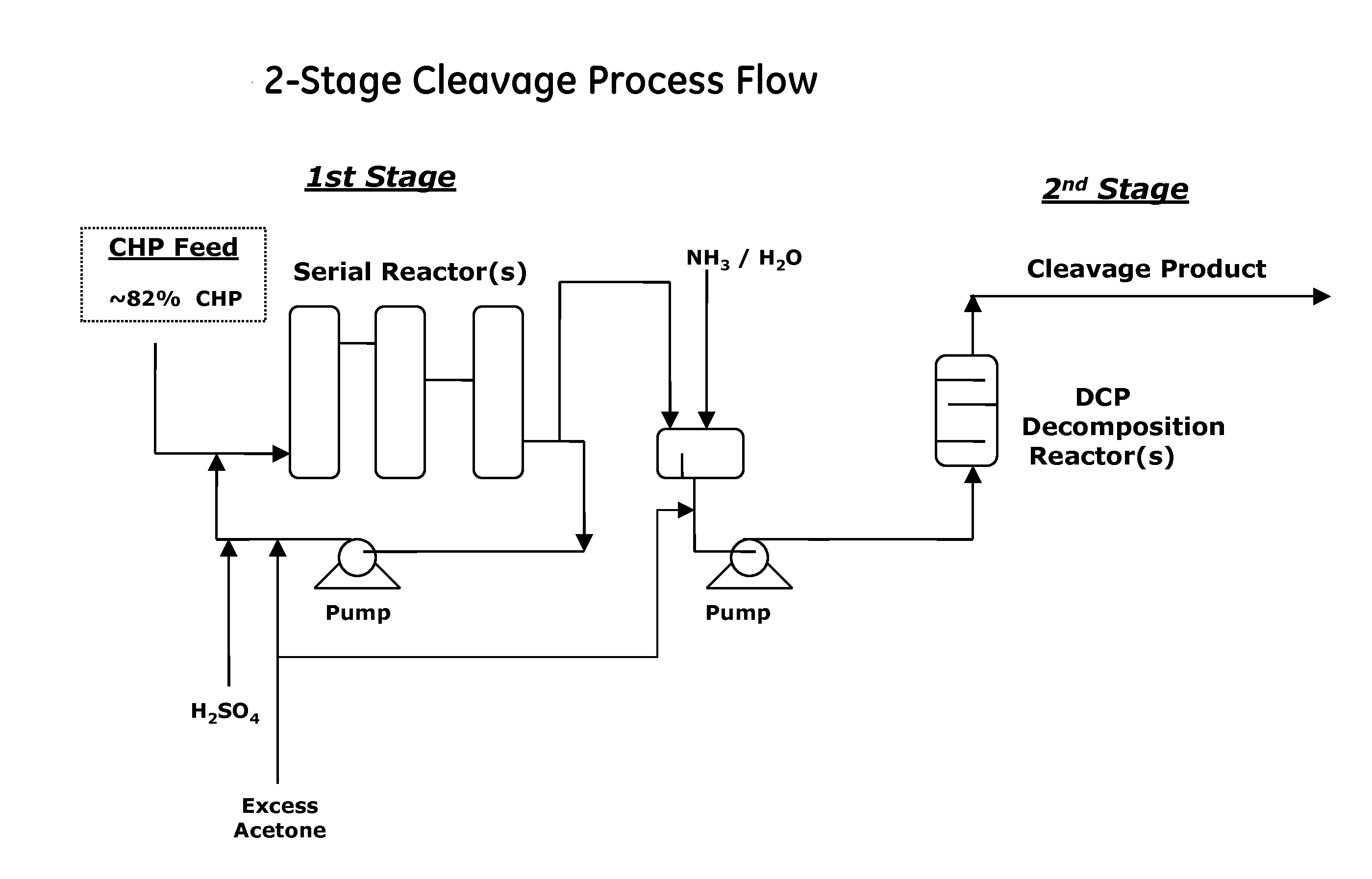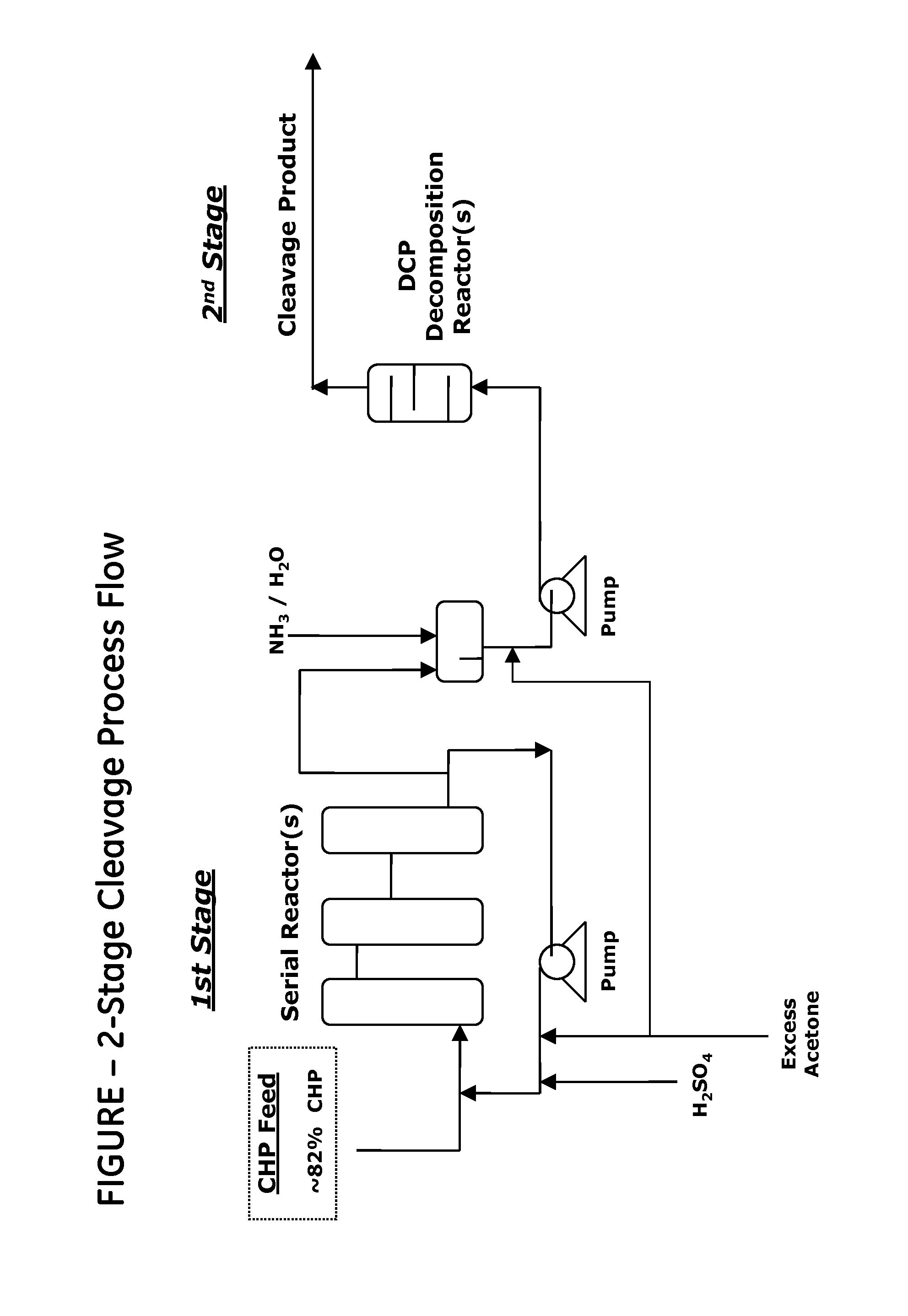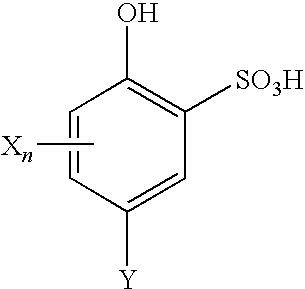Method for producing phenol and acetone
a technology of acetone and phenol, which is applied in the field of industrial organic synthesis, can solve the problems of increased processing complexity, increased power consumption, and inability to meet the requirements of industrial production, and achieves the effect of reducing the cost of production, and improving the quality of production
- Summary
- Abstract
- Description
- Claims
- Application Information
AI Technical Summary
Problems solved by technology
Method used
Image
Examples
example 1
[0035]Cumene hydroperoxide is decomposed using a pilot plant comprising two reactors: a first-stage CHP decomposition reactor that has a volume of 12 mL and is provided with a circulation loop, and a second-stage reactor that has a volume of 7 mL and is a displacement reactor. Part of the reaction mass from the first-stage reactor is fed to the second-stage reactor, and part of the mass is returned to the inlet of the first-stage reactor, and is thereby circulated. A catalyst and a raw material are fed to the reaction mass stream at the inlet to the first-stage reactor. The composition of the raw material is shown in Table 1.
TABLE 1Raw material used for the decomposition of CHPComponentContent, mass %1Cumene hydroperoxide (CHP)74.552Cumene14.223Dimethylphenylcarbinol (DMPC)2.614Acetophenone0.325Water0.716Dicumyl peroxide (DCP)0.217Phenol0.768Acetone6.379Unidentified0.25
[0036]The CHP decomposition reactor was charged with the technical-grade CHP having the composition shown in Table ...
example 2
[0038]CHP was decomposed using the same equipment and under the same conditions as in Example 1, except that a freshly prepared solution of 2-hydroxy-5-cumyl-benzenesulfonic acid (where n is 0, Y is 1-methyl-1-phenylethyl) having a concentration of 0.32 mol / L was used as a catalyst. The catalyst solution was fed at a rate of 50 μL / hour, whereby a concentration of 0.5 mmol / L (0.015% or 150 ppm) was maintained in the reaction mass. The composition of the CHP decomposition reaction mass after leaving the second stage reactor is shown in Table 3.
TABLE 3Composition of CHP decomposition reaction massComponentConcentration, mass %Phenol40.4Acetone43.73Dicumyl peroxide (DCP)0.02Dimethylphenylcarbinol (DMPC)0.04Cumylphenols0.24Total of α-methylstyrene dimers0.07Acetophenone0.46α-Methylstyrene (AMS)1.44Cumene11.73Hydroxyacetone0.03Mesityl oxide0.01Unidentified0.44Water1.39
example 3
[0039]CHP was decomposed using the same equipment and under the same conditions as in Example 1, except that the temperature in the first stage was 40° C., and a freshly prepared solution of 4-hydroxybenzene-1,3-disulfonic acid (where n is 0 and Y is SO3H) having a concentration of 0.32 mol / L was used as a catalyst. The catalyst solution was fed at a rate of 100 μL / hour (1 mmol / L (0.025% or 250 ppm) in the reaction mass). The composition of the CHP decomposition reaction mass after leaving the second stage reactor is shown in Table 4.
TABLE 4The composition of the CHP decomposition reaction massComponentConcentration, mass %Phenol39.43Acetone43.9Dicumyl peroxide (DCP)0.02Dimethylphenylcarbinol (DMPC)0.07Cumylphenols0.34Total of α-methylstyrene dimers0.19Acetophenone0.46α-Methylstyrene (AMS)1.39Cumene11.81Hydroxyacetone0.09Mesityl oxide0.02Unidentified0.67Water1.61
PUM
| Property | Measurement | Unit |
|---|---|---|
| Temperature | aaaaa | aaaaa |
| Temperature | aaaaa | aaaaa |
| Percent by mass | aaaaa | aaaaa |
Abstract
Description
Claims
Application Information
 Login to View More
Login to View More - R&D
- Intellectual Property
- Life Sciences
- Materials
- Tech Scout
- Unparalleled Data Quality
- Higher Quality Content
- 60% Fewer Hallucinations
Browse by: Latest US Patents, China's latest patents, Technical Efficacy Thesaurus, Application Domain, Technology Topic, Popular Technical Reports.
© 2025 PatSnap. All rights reserved.Legal|Privacy policy|Modern Slavery Act Transparency Statement|Sitemap|About US| Contact US: help@patsnap.com



